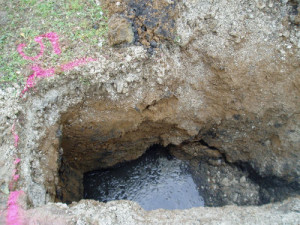Challenge
Mundell was contracted by a client to evaluate polychlorinated biphenyl (PCB) contamination identified in the subsurface at a client-owned property (Site) in Kokomo, Indiana. The Site is separated from the historic Continental Steel Superfund facility by Wildcat Creek. It is adjacent to a property currently owned by an excavation contractor, where PCB levels had been identified in the subsurface at similar and higher levels. Additionally, the Site was historically owned by the adjacent property owner. Mundell was tasked with determining whether impacts observed on site were likely associated with client actions, or may have been caused by another entity, such as the adjacent property owner.
Action
Mundell researched parcel ownership information, and evaluated aerial photos to piece together a better understanding of the development of the client site. Mundell also evaluated historic flood levels along the adjacent creek to determine if flooding associated with Continental Steel site contamination on the north side of the creek could have caused the PCB contamination observed at the Site.
Results
The results of the investigation indicate that the PCB contamination is generally consistent with locations of waste debris fill material, which is more prevalent across the adjacent property. Based on parcel ownership, aerial photo evidence, and evaluation of other possible contaminant emplacement mechanisms, Mundell determined that there was no other viable explanation to account for the presence of the contamination other than historic burial activities associated with the adjacent property owner prior to the sale of the property to the Mundell client.
While the findings were being considered in ongoing legal proceedings, Mundell was required by the state regulatory agency to nonetheless develop a cleanup plan. The relevant regulations are associated with federally managed self-implementing polychlorinated biphenyl (PCB) cleanups, per 40 CFR 761.61.
As outlined in 40 CFR 761.61(a), a property can be classified as either a high or low occupancy area. Under each of these occupancy classifications, different cleanup levels are required, depending on the level of engineering controls that will exist:
- (high occupancy, with no other controls: PCB cleanup goal <= 1 ppm)
- (high occupancy, with cap: PCB cleanup goal >1 and <= 10 ppm)
- (low occupancy, with no other controls: PCB cleanup goal
- (low occupancy, with fence, signage: PCB cleanup goal <25 ppm and <= 50 ppm)
- (low occupancy, with cap: PCB cleanup goal >25 ppm and <= 100 ppm)
Mundell worked with United States Environmental Protection Agency (U.S. EPA) personnel to develop a work plan that was reviewed and subsequently approved. To guarantee the most potential resale value for the client property, the work plan developed by Mundell would plan to achieve the most conservative cleanup goals (<=1 ppm with no institutional controls required); features that could otherwise restrict the usage of the property for current or future owners. After completion of remedial activities, an Implementation Report will be submitted to the U.S. EPA.




